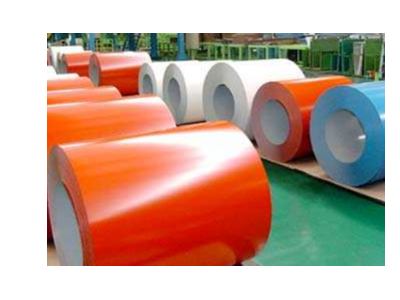怎样进行彩涂板生产线液压系统泄漏的诊断和防治
唐山天物彩板专注彩板16年——常州彩涂板现货销售_常州彩涂板价格 更多信息请拨打网站上方电话咨询了解

液压系统泄漏问题在彩涂板机组中是一种很普遍的现象,泄漏严重时还会引起系统中的执行件动作失效。因此,泄漏也属于液压系统故障的一种形式。
A泄漏的分类
(1)外泄漏。外泄漏是指由液压站与执行元件之间的管道、管接头或系统的吸油口的泄漏,通常可以归纳为能看得见的泄漏。外泄漏通常会在液压系统泄漏问题在彩涂板机组中是一种很普遍的现象,泄漏严重时还会引起系统中的执行件动作失效。因此,泄漏也属于液压系统故障的一种形式。
(2)内泄漏。内泄漏是指液压元件内部的泄漏,轻微的内泄漏是不容易察觉到的,但随着时间的推移和内泄漏油量的增加,液压系统会出现过热的现象,元件的动作会失效。判断某一元件是否出现内泄漏的方法比较简单,是以元件空载和满载时各执行动作一次,对比一下两个工作时间,如果满载时的执行时间比空载时的执行时间长很多,则可以认为该元件有内泄漏。
B泄漏的原因
(1)工作压力。液压系统的工作压力调得越高,系统泄漏的可能性就越大。因此,在生产过程中,系统压力不能长时间超过系统设计时根据计算所定的压力最佳值。
(2)工作温度。系统在工作过程中,所损失的能量大部分变为热能,一部分通过液压元件本身、管道和油箱的表面散发到大气中,其余的就传递给液压油,使油温升高。油温升高会带来一系列的问题:一是会使油液的黏度降低,使系统泄漏的可能性增加,还会造成密封元件加快老化、提前失效,或引起更严重的泄漏。
(3)油液的清洁度。油液如果不清洁,比如内含有铁屑、涂料、灰尘和脏物等杂质都会使液压元件的滑动表面磨损,最终引起内泄漏。平时我们遇到的如阀芯卡阻、小孔堵塞、密封件损坏等都属于油液清洁度的原因。
C防泄漏方法
生产过程中,首先要严格控制工作压力和控制工作温度。工作压力应按设计范围内调节,工作温度应在55-65℃的范围内调节,最大不能超过70℃,必要时应加装油液的冷却装置。另外要保证液压油的清洁度,并选用合适的密封装置,避免因密封材料和密封形式不合理而造成介质泄漏。
在日常维护中,要定期化验液压油,确保油质符合标准。生产时,维修人员和操作工都要随时检查液压管道和液压执行元件的泄漏情况,及时维护,减少损失。
Leakage of hydraulic system is a very common phenomenon in color painting machine set. When the leakage is serious, it will cause the action failure of the actuator in the system. Therefore, leakage is also a form of hydraulic system failure.
Classification of A Leakage
(1) leakage. Outer leakage refers to the leakage of pipelines, pipe joints or oil suction ports of systems between hydraulic stations and actuators, which can usually be summed up as visible leakage. Outer leakage usually occurs during the
operation of production line as follows: air bubbles in hydraulic oil; unstable movement of hydraulic system and creeping phenomenon; overheating of hydraulic system; increase of tank pressure; increase of pump noise.
(2) Internal leakage. Internal leakage refers to the internal leakage of hydraulic components, slight internal leakage is not easy to detect, but with the passage of time and the increase of internal leakage oil, the hydraulic system will be
overheated and the action of components will fail. The method of judging whether an element has internal leakage is relatively simple. It is to perform each action once when the element is unloaded or full-loaded. Comparing the two working hours,
if the execution time at full-load is much longer than that at no-load, it can be considered that the element has internal leakage.
Reasons for B Leakage
(1) Work pressure. The higher the working pressure of the hydraulic system is adjusted, the greater the possibility of system leakage. Therefore, in the process of production, the system pressure can not exceed the optimum value of the pressure
determined by the calculation when the system is designed for a long time.
(2) Working temperature. During the working process, most of the energy lost in the system becomes heat energy. Some of the energy is emitted into the atmosphere through the hydraulic components themselves, pipelines and the surface of the
tank. The rest is transferred to the hydraulic oil, which makes the oil temperature rise. The increase of oil temperature will bring a series of problems: first, it will reduce the viscosity of oil, increase the possibility of leakage of the system,
and also cause accelerated aging of sealing elements, premature failure, or even more serious leakage.
(3) Oil cleanliness. If the oil is not clean, such as containing iron scraps, paint, dust and dirt and other impurities, it will make the sliding surface of hydraulic components worn and eventually cause internal leakage. Usually we encounter
such as valve core blockage, small hole blockage, seal damage and so on, all belong to the reason of oil cleanliness.
C leak-proof method
In the production process, first of all, the working pressure and temperature should be strictly controlled. The working pressure should be adjusted in accordance with the design range, and the working temperature should be adjusted in the
range of 55-65 degrees C. The maximum temperature should not exceed 70 degrees C. When necessary, the cooling device of oil should be installed. In addition, the cleanliness of hydraulic oil should be ensured, and appropriate sealing devices should
be selected to avoid medium leakage due to unreasonable sealing materials and sealing forms.
In daily maintenance, periodic testing of hydraulic oil should be carried out to ensure that the oil quality meets the standards. During production, maintenance personnel and operators should check the leakage of hydraulic pipelines and hydraulic
actuators at any time to maintain in time and reduce losses.